SB 177 report: most IEA transports involve law enforcement; restraints common during sheriff transports
November 22, 2025 | Health, Human Services and Elderly Affairs, House of Representatives, Committees , Legislative, New Hampshire
This article was created by AI summarizing key points discussed. AI makes mistakes, so for full details and context, please refer to the video of the full meeting. Please report any errors so we can fix them. Report an error »

Officials from New Hampshire Hospital and the New Hampshire Hospital Association presented the SB 177 report on involuntary emergency admissions (IEA) transports and restraint use to the oversight committee on Nov. 21.
Cynthia Gabones, chief community integration officer at New Hampshire Hospital, summarized year-six statistics and said the report covers transports between Oct. 2024 and Sept. 2025. The presenters described an average of 126 transports per month and said roughly 36% of transports were by ambulance while about 61.5% involved law enforcement. They reported that around 47% of transports occurred without restraints and approximately 51% had restraints applied before transport; restraint types included combination restraints (~40%), handcuffs only (~12%) and waist-belt only (~46.5%). Presenters noted most restraints occur during sheriff transports.
Committee members asked what statutory criteria require an IEA petition and who certifies it; presenters cited state statute governing involuntary admissions and explained that a certifying practitioner in an emergency department typically completes the petition. They also explained that a statutory update allowed clinicians and emergency departments to decide whether an ambulance or sheriff should perform a transport, though ambulance availability can still make sheriff transport the default.
Members raised questions about legal challenges and oversight; presenters said they were not aware of lawsuits tied to restraints under the current reporting period and described multiple procedural safeguards including probable-cause hearings and legal representation that occur in the IEA process.
Presenters offered to provide additional breakdowns (for example, percent of sheriff transports that used restraints) and to answer follow-up queries from members interested in operational training or alternative restraint tools.
Cynthia Gabones, chief community integration officer at New Hampshire Hospital, summarized year-six statistics and said the report covers transports between Oct. 2024 and Sept. 2025. The presenters described an average of 126 transports per month and said roughly 36% of transports were by ambulance while about 61.5% involved law enforcement. They reported that around 47% of transports occurred without restraints and approximately 51% had restraints applied before transport; restraint types included combination restraints (~40%), handcuffs only (~12%) and waist-belt only (~46.5%). Presenters noted most restraints occur during sheriff transports.
Committee members asked what statutory criteria require an IEA petition and who certifies it; presenters cited state statute governing involuntary admissions and explained that a certifying practitioner in an emergency department typically completes the petition. They also explained that a statutory update allowed clinicians and emergency departments to decide whether an ambulance or sheriff should perform a transport, though ambulance availability can still make sheriff transport the default.
Members raised questions about legal challenges and oversight; presenters said they were not aware of lawsuits tied to restraints under the current reporting period and described multiple procedural safeguards including probable-cause hearings and legal representation that occur in the IEA process.
Presenters offered to provide additional breakdowns (for example, percent of sheriff transports that used restraints) and to answer follow-up queries from members interested in operational training or alternative restraint tools.
View the Full Meeting & All Its Details
This article offers just a summary. Unlock complete video, transcripts, and insights as a Founder Member.
✓
Watch full, unedited meeting videos
✓
Search every word spoken in unlimited transcripts
✓
AI summaries & real-time alerts (all government levels)
✓
Permanent access to expanding government content
30-day money-back guarantee

